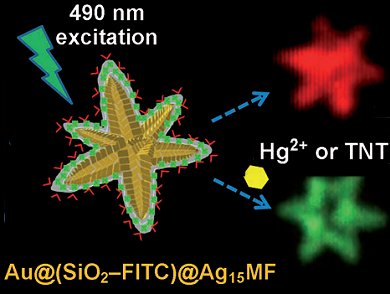Single-Molecule Detection
Highly sensitive and highly selective tests are important for the early detection of disease, the detection of environmental toxins, or for the detection of explosives at airports. Increased selectivity for the target analytes helps to avoid false-positive results. In the journal Angewandte Chemie, Indian scientists have now introduced a specific detection method for the explosive TNT that can be used to detect even a single molecule.
Thalappil Pradeep, Ammu Mathew, and P. R. Sajanlal at the Indian Institute of Technology Madras use an ingenious combination of micro- and nanostructures as sensors: gold mesoflowers, flower-shaped gold particles about 4 µm in size, act as supports for silver clusters, tiny clumps of exactly 15 silver atoms embedded in the protein bovine serum albumin. When irradiated with light of the right wavelength, the silver clusters luminesce, giving off red light. The gold of the mesoflower supports intensifies the fluorescence. Their unique shape is a particular advantage, because it is easy to unambiguously identify under an optical microscope, unlike spherical particles.
If a drop of a solution containing TNT is applied, it reacts with the amino groups of the bovine serum albumin to make a Meisenheimer complex—a reaction specific to TNT. This extinguishes the red glow of the silver clusters. In order to make this reaction even more distinct, the researchers also embedded a green fluorescing dye, which was adsorbed on a silicon dioxide layer grown on the gold flowers. As long as the silver clusters glow red, the green fluorescence is suppressed. When TNT molecules switch off the red light, the green dye begins to glow. The color change from red to green can be observed with a fluorescence microscope.
Sub-zeptomole Detection Range with SERS
A TNT concentration of one ppb (part per billion) extinguishes the fluorescence, one ppt (part per trillion), reduces it markedly. The researchers supplemented their luminescence technique with a second analytical method, SERS (surface-enhanced Raman scattering), which also functions extremely well with a version of the flower-shaped sensors. “This allowed us to attain detection limits as low as the sub-zeptomole range (10–21 mol),” explains Pradeep. Just one “flower” is enough to operate as a sensor. It reacts when it comes into contact with as few as nine molecules. A device based on this principle is under development.
The researchers were also able to detect mercury with similar sensitivity by using the same sensor strategy. Says Pradeep: “Our concept could also be used for the ultra-trace analysis of other substances through the incorporation of specific ligands on the sensors.”
Image: © Wiley-VCH
- Selective Visual Detection of TNT at the Sub-Zeptomole Level,
Ammu Mathew, P. R. Sajanlal, Thalappil Pradeep,
Angew. Chem. Int. Ed. 2012.
DOI: 10.1002/anie.201203810



